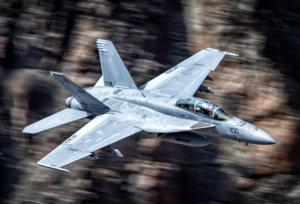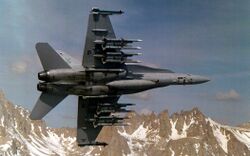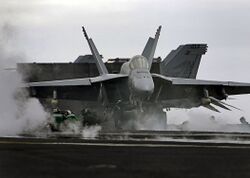JAS-18 Ekara
| JAS-18 Ekara | |
|---|---|

| |
| An Acrean Navy JAS-18F | |
| Role | Multirole fighter |
| National origin | |
| Manufacturer | Vogt GmbH |
| Design group | Vogt GmbH Tionscail Ríoga Aeraspáis |
| First flight | 12 May 1975 |
| Introduction | 14 July 1980 |
| Status | In active service |
| Primary user | |
The Vogt JAS-18 Ekara is a twin-engine, 4th generation fighter produced by Vogt ASA for the Royal Acrean Navy and the Royal Acrean Air Force. The JAS-18 was developed with assistance from Tionscail Ríoga Aeraspáis as part of the joint Flygsystem 80 project.
Compared to the Ossorian-produced T-30, the JAS-18 is approximately 20% larger and a couple thousand kilograms heavier. To compensate for the increased size and weight, the Ekara was equipped with more powerful domestic Acrean engines. It also was equipped with a different avionics suite, and different onboard air-to-ground systems. Later Ekaras introduced new avionics, systems, and weapons which had been developed for later production fighters with refits derived from later fighter development programs.
Development
Design
The JAS-18 Ekara is a twin engine multirole tactical fighter. It was designed to be highly maneuverable, cost effective, and easy to maintain. The JAS-18 debuted with substantial changes from the T-30 to enhance its kinematic and flight performance; it was fitted with more powerful engines and enlarged intakes Moderate improvements were made to the aircraft over its lifespan in service. The Block II production lot introduced thrust vectoring with the multi-axis MAVS system, which was integrated with a new flight control system. This modification heavily increased the flight performance of the airframe; in addition to providing it with exceptional low-speed authority, it also enhanced energy performance by utilising both the MAVS system and flight control surfaces to maneuver the aircraft with the least amount of drag.
Modern Ekaras since the JAS-18E/F model have been made with composite construction to enhance their radar cross section. Radar and sensor systems are largely shared derived from the EFX fighters, and their sensors and computer systems constitute the most complex and expensive parts of the aircraft's development.
Avionics
The Ekara E/F uses an integrated avionics suite which incorporates a high degree of sensor fusion. Key sensors on the aircraft are its Kobalt-Zeiss AR/ASM-79 active electronically scanned array (AESA) radar and itsMDA EK/RMG-11 electronic warfare and countermeasure system. The AR/ASM-06S radar is reported to provide a tracking range in excess of 150km
Beginning in 2008, Ekaras have been equipped with the ERMG-11 electronic warfare system. ERMG-11 is a gallium nitride-based electronic warfare suite which uses networked sensors ad emitters, both onboard and from other platforms, giving the pilot an ability to silently geolocate airborne and ground-based threats while preventing its own detection through actively countering enemy sensors. Working in conjunction with other GUNGNIR-equipped fighters, linking allows the individual aircraft to have exceptional situational awareness even without an active AEW&C aircraft for support. This situational awareness allows a Draken pilot to avoid threat zones, while its electronic warfare systems allow them to obfuscate enemy sensors, all together resulting in an exceptional ability to remain undetected.
Cockpit
The Ekara uses a full glass cockpit and all-digital flight instruments. The head's up display (HUD) is used as the primary flight instrument, with symbology and information for various flight modes displayed for the pilot. was displayed originally on three large liquid-crystal multi-function Head's Down Displays (HDDs) arranged in the cockpit. This cockpit design was updated for the Block IV-E/F aircraft. The three LCD MFD displays were replaced by a single large LCD touchscreen multi-function wide area display with further improved fidelity and resolution, complimented by two additional smaller displays on either side of the cockpit in a similar arrangement to the EF-650 Striga. Despite the addition of touchscreen capability, tactile buttons for manipulating the MFDs were retained by demand of pilots. The cockpit displays underwent additional updates in 2015. The Ekara E/F also implemented a new helmet-mounted display system (HMDS), allowing pilots to display all flight and combat information, usually displayed on the HUD, in their visors.
JAS-18E/F
The failure of a prospective next generation naval fighter designed off the back of the EF-662 Vampyr led the Acrean Navy to issue a requirement for an updated strike fighter in 1993. The requirement led to several designs being created to meet the tender, though the one that was ultimate selected was a massive overhaul of the JAS-18, which was eventually given the designation JAS-18. The aircraft were fully new production, constructed from composite materials with legacy subsystems removed and replaced with modern modular electronics. Newer and more powerful engines were installed, improving the aircraft's kinematic performance.
Operational History
Refusal War
The JAS-18 made its combat debut during the Refusal War, where it deployed in support of Royalist forces and Acrean ground force advisers for the duration of the conflict. The multirole capability of the Ekara was used to great effect, enabling JAS-18 strike packages to escort themselves and thus free up dedicated air superiority squadrons to be available for a greater number of escort missions for more vulnerable strike aircraft.. The Ekara became well known for its involvement in several air-to-air engagements over Syara against Cacertian aircraft from 1985 to 1987, during which Acrean Navy pilots shot down a number of Cacertian naval strike fighters, resulting in the deaths of at least two Cacertian pilots.
Zemplen War
Acrean JAS-18s were deployed in Ruvelka to provide point air defence and strike capabilities for Ruvelkan forces during the Zemplen War. Compared to other Acrean airframes, they accounted for a combined total of 31 shoot-downs of enemy aircraft of various types over the course of their deployment, but made up a significant portion of allied Acrean-Ruvelkan long range strike capability. High-end electronic warfare capabilities provided by Acrean JAS-18s were often critical to many strike missions. Several JAS-18s were lost in combat.
Midsummer War
JAS-18s based on the aircraft carriers RAS Oceana and RAS Rouen played a major part in the initial air campaign over Aethurheim. Participating in both counter-air and strike missions, the Oceana's and Rouen's carrier air wings engaged in heavy sustained combat operations over western Aethurheim, and in addition to hundreds of strike sorties also claimed 38 aerial victories.
Variants
JAS-18A/B
The JAS-18A and JAS-18B were the first production variants of the Ekara which entered service in 1978. The single-seat JAS-18A was the primary strike fighter variant, carrying slightly more internal fuel and a lighter radar. The slightly larger two-seat JAS-18B was developed as an alternative variant for long-range strike duties, with the radar intercept officer able to utilise the necessary targeting pods and systems to employ advanced guided air-to-ground munitions with more ease than a single-seat aircraft. The JAS-18B was also employed as a fleet defence interceptor, carrying a more powerful, longer-ranged radar which allowed tracking of up to 15 targets simultaneously with weapons guidance against up to 4 simultaneously.
The JAS-18A/B Block II upgrade was introduced in 1983, and primarily offered systems upgrades in the form of improved cockpit displays and an upgrade to the radars, using newer digital components to improve performance.
JAS-18C/D
JAS-18E/F
JAS-18Q
Operators
Current Operators
Former Operators
Specifications (JAS-18E/F)
General Characteristics
- Crew: JAS-18E: 1, JAS-18F: 2
- Length: 18.31 m
- Wingspan: 13.62 m
- Height: 4.88 m
- Wing Area: 46.5 m²
- Empty Weight: 14,552 kg (32,081 lbs) without conformal fuel tanks
- Max Takeoff Weight: 29,937 kg (66,000 lbs)
- Powerplant: 2x MDA EJ-900-5/10 afterburning turbofans, 90 kN (20,233 lbf) dry thrust, 145 kN (32,500 lbf) reheat
- Fuel Capacity: JAS-18S: 6,667 kg (14,700 lbs) internal without conformal fuel tanks, JAS-18SF: 6,241 kg (13,760 lbs) internal without conformal fuel tanks
Performance
- Maximum Speed: Mach 2 at altitude
- Mach 1.4 supercruise at altitude
- Service Ceiling: 20,000 m (65,000 ft)




